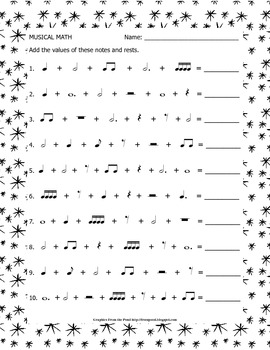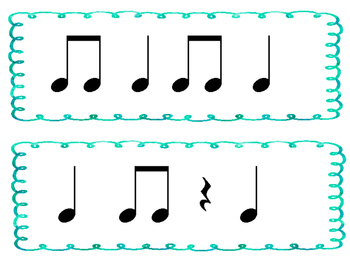


Here, we have a quarter and eighth notes producing a bar of sixteenth notes. You can count as follows: 1-e-and-a, 2-e-and-a, 3-e-and-a, 4-e-and-a (four - ee - and - a). The note stems are connected in groups of four with two horizontal lines. They will compare and contrast the rhythms of marches and jazz based on the examples in a documentary, and explore notation, subdivision of notes and the altered and innovative rhythms found in jazz music. Here, we have a measure of sixteenth notes. In this music lesson, students learn about the use of fractions in music. Provide the answers for the first column of 'facts', and then try to beat your score with more correct answers, or by racing the clock to complete the second and third columns in record time. Therefore one can certainly find performances which don't match examples I provided, and also different versions of the scores. Connect music and math through the study of jazz. Drill three essential rhythmic values (quarter, eighth and sixteenth notes) with this musical math fact worksheet. The widely circulated scores in turn are often not written not by composers, but transcribed from some particular recordings. I'd like to point out that rhythm in various jazz performances often vary significantly, and is modified by the musicians. Quarter-note triples are to be performed as written. The resulting rhythm might not be easy to notate explicitly but at high tempo of the tune the swing will be rather shallow and the whole sequence can be played as an ornament, following intuition.Īnd for completeness All of Me by Gerald Marks and Seymour Simons: the sixteen-note triplet should take time of the first swinged eight note. However in this example from Charlie Parker's Billie's Bounce: However, students who learn eighth notes from the beginning through chanting in a syllabic system of counting (without the mathematical explanation, which. Sixteen notes are meant to be played straight, and groups including sixteen notes as well, so here at the beginning we have a sixteen-note triplet, followed by two sixteen-notes, followed by 4 sixteen-notes, followed by swinged rhythm in the next measure. Hand out and complete ' Rhythms Worksheet. Note that when you group two 16th notes, that it is the same as one 8th note, and that the dot is representing the third 16th note.

Sixteen notes appear rarely in lead sheets, more often in solo transcriptions, but I found this example of Armageddon by Wayne Shorter: Fill a measure with 16 16th notes and group them together, writing the fraction equivalents underneath e.g., (3/16 + 1/16) + (3/16 + 1/16) + (3/16 + 1/16) + (3/16 + 1/16). The triplets are played as triplets, the eight-notes are swinged. Note that the word "swing" is not even written in the score, as it is left to the musician's taste whether and how deeply swing the eight notes.Įdit: It was pointed out in the comments that Night in Tunisia was composed in straight feel, and while some notable musicians performed it in swing feel, I tried to add some less controversial examples. this example of Dizzy Gillispie's Night in Tunisia: What you named "Swing time option 2" is the standard notation of swinged eight notes and triplets used in jazz scores.


 0 kommentar(er)
0 kommentar(er)
